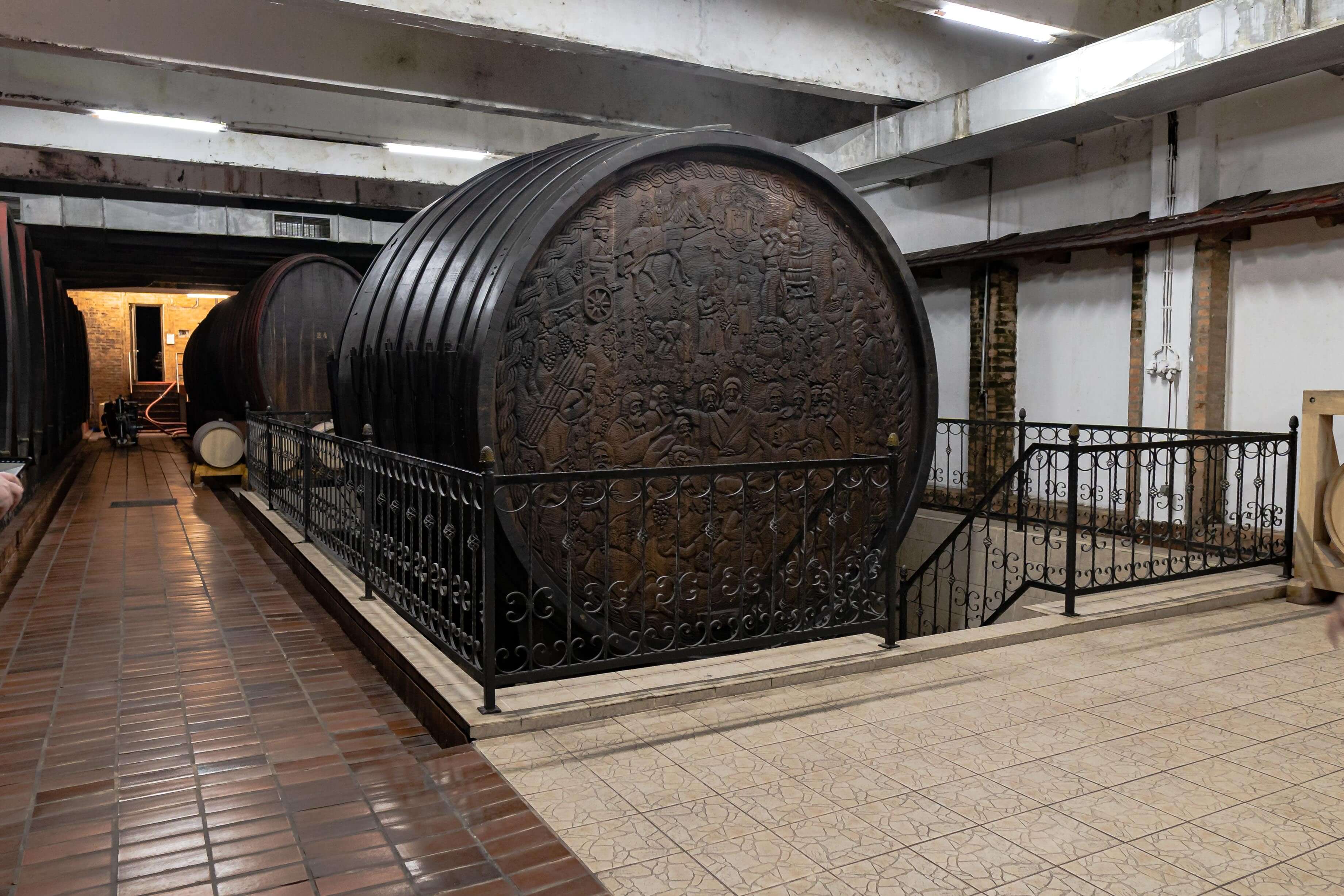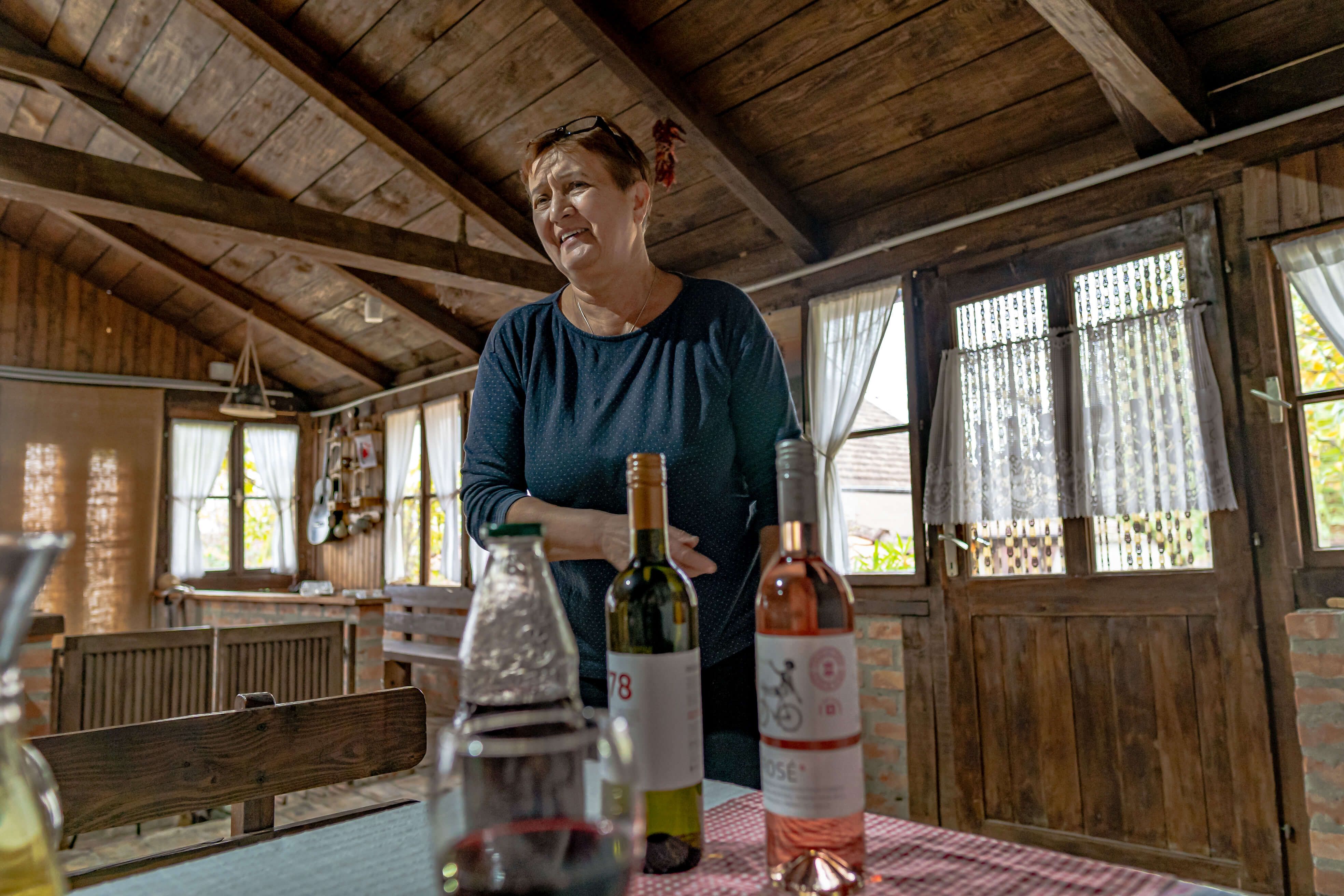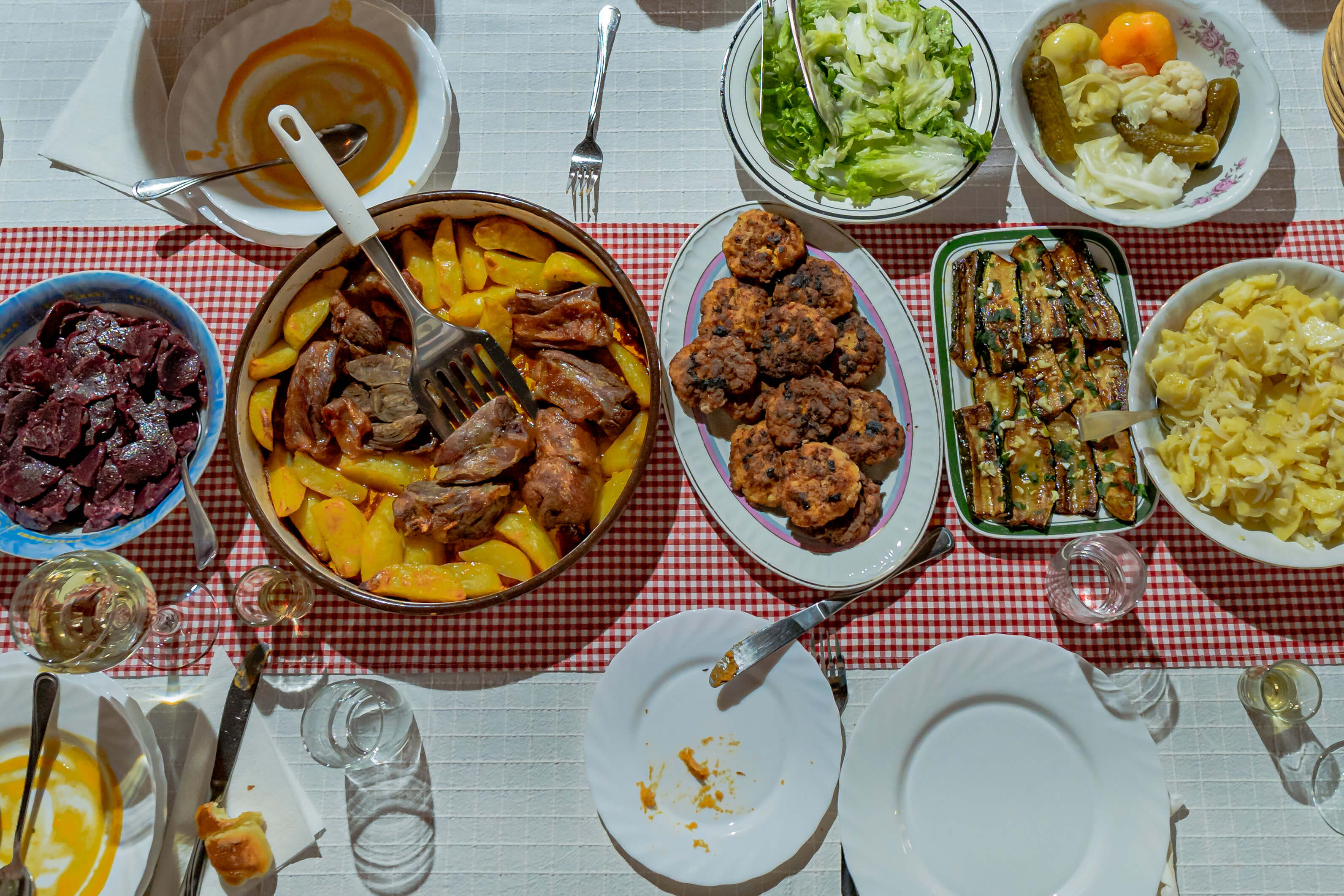Discover the Croatian Danube: Synergy Between People and Grapes in Erdut
September 7, 2022 – Picture this. You took a weekend off and spent it in nature, fishing, camping by the Danube, and eating delicious fish stew. It would be silly to stop there, wouldn’t it? Nothing better to round it all up than more homemade food and outstanding wine. Balance it out with some physical activity. Head east from Aljmaš, follow the 11-kilometre-long promenade and you will arrive in Erdut. Located 37 kilometres from Osijek, you might have heard of it in the context of the Erdut Peace Agreement of 1995, otherwise an unknown place. If you just scratch the surface, though, you will discover a lot. We’ll start you off by telling you about its mystery, wine, and its people.
Historically, Erdut has been a calm small town where cultures intertwined. It was first mentioned in 1335 as Erdöd, and with the status of a town in 1472 as Castellum Erdeed. The name originates from a Hungarian word denoting a forest path or road. From the 15th century until World War II, it was passed from hand to hand between noble families. Among them were the Adamović Cseh family, whose 19th-century manor still stands in the centre of town. The manor is not the only piece of architecture worth visiting.
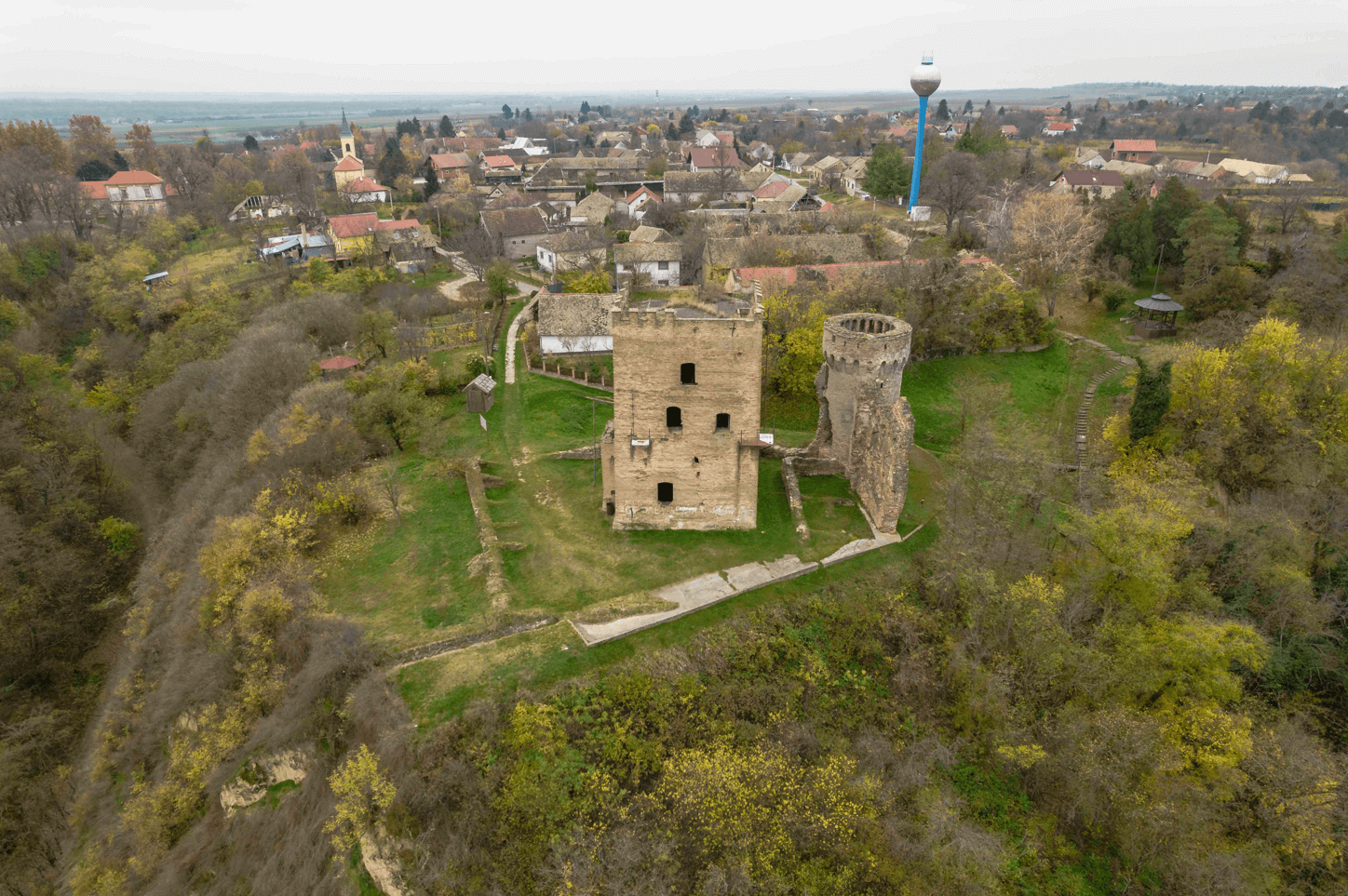
A mysterious medieval-looking castle stands on the bank of the Danube. There is no written information on its origins, but there are a few legends surrounding it. Each generation probably comes up with its own stories. Nada Bućkalović wrote about one of them where fairies would keep destroying at night whatever the builders would build during the day. To get them to stop doing that, they had to sacrifice a breastfeeding mother by building her into one of the pillars of the castle. According to Nada, the memories of the legend were refreshed when the grave in the basement was robbed. The pillar at the entrance was damaged, revealing a 180 cm tall skeleton, with a 150 cm long braid. Nowadays, the castle is a zero-category monument standing on top of a hill right next to the Danube. Local rock climbing associations like using it for practice, but you don’t have to be an expert to climb up the hill and explore its old walls. The Stairway of Health in the park right next to the castle will also take you up and down for a refreshing walk by the Danube.
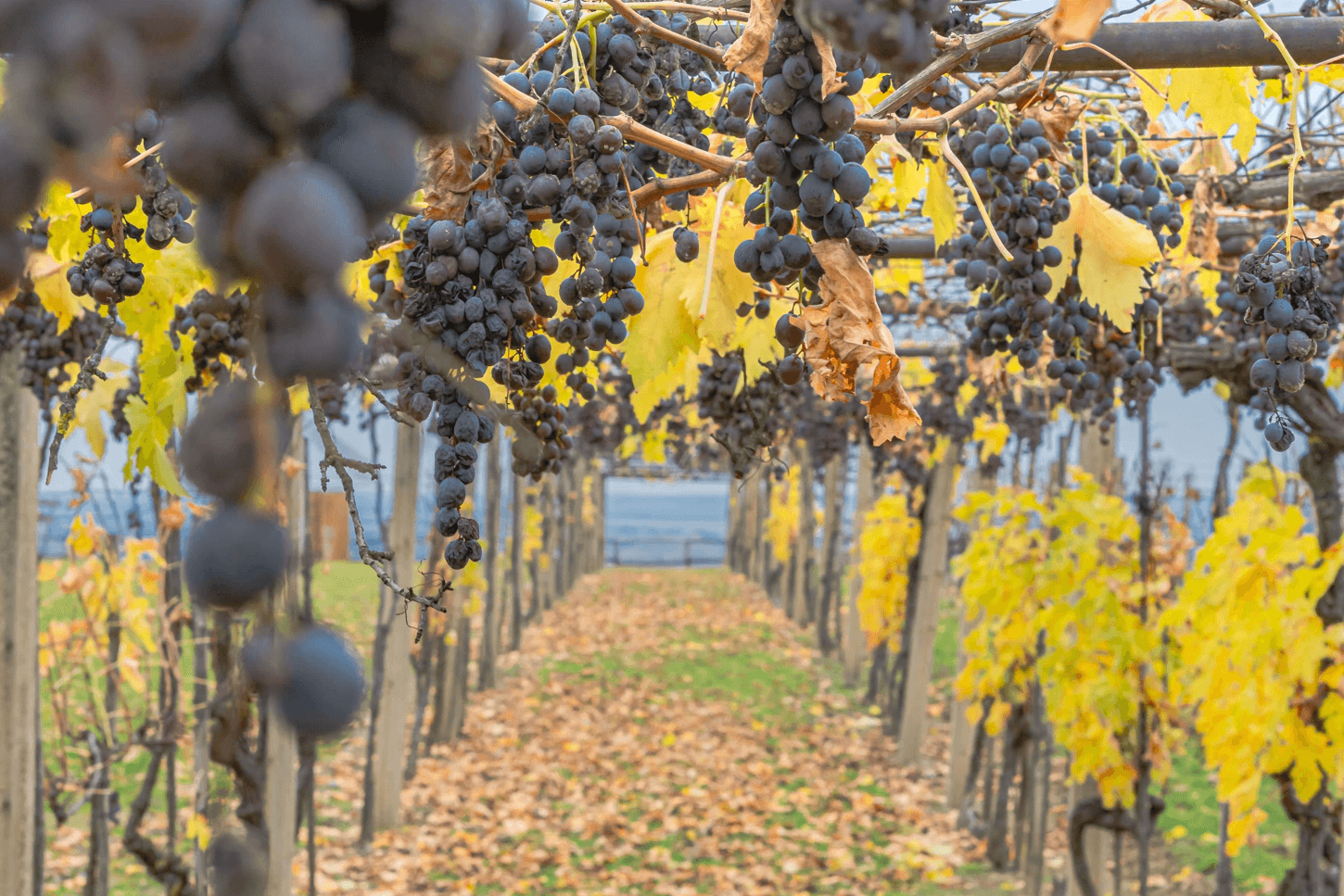
Having touched on movement, this is the perfect opportunity to remind you of Erdut’s traditional Wine & Bike Tour. Usually taking place right in the middle of autumn grape harvests, this event attracts hundreds of visitors each year, all looking for good fun, healthy competition, and, of course, excellent local wine. Thanks to its geographical position, the Erdut municipality is famous for its vineyards, which stretch as far as the eye can see.
Erdut alone is home to multiple wineries, harvesting the famous Traminac, Graševina, Chardonnay, Riesling, etc. Graševina is the trademark wine of Erdut, and there is so much of it there that they had to build the world’s largest barrel to keep it all.
An incredible 2,5 tonnes of iron keeps the wooden construction in place. It has been listed in the Guinness Book of World Records, and it can keep 75 thousand litres of wine, equaling 100 thousand bottles! It was made in 1989 by DIK Đurđenovac, using the traditional method of construction with a total of 109 oak trunks which were by that point over 100 years old. The motifs of the traditional Croatian interlace and the Last Supper were carved by Naïve sculptors Tijardović and Fodor. The barrel has been kept full of Graševina ever since its construction. Not that its integrity is ever to be doubted, but it has been placed over a specially constructed pool that would salvage the gold-coloured nectar of life in case the barrel ever started leaking.
A day of sightseeing, cycling, walking, and wine tasting will surely make you quite hungry. Worry not! Though there is no restaurant in Erdut, the locals will be more than happy to feed you homegrown and homemade local food full of flavour, protein and healthy* fat, vitamins, and all the other nutrients your body and soul might need. One of them is teta Zlatica.
She is the perfect representative of what happens when you’re born and raised in a place like Erdut. Like many others in Slavonia, her family has faced all kinds of adversity during the Homeland war, and was left without a penny or a house. After going off into the world and becoming and successfully running a couple of businesses, her heart eventually took her back to Erdut to rebuild her family home and live off the land on the picturesque hills. She has decided to leave everything else and do what she does best and enjoys the most – open her home, her kitchen, and her heart to the curious wanderers who come to explore and experience Erdut. She is one of the residents in Erdut whose happiness is contagious. They all work together, driving change and inspiring progress. It is this synergy (along with their wine) that we believe will get them far and make you feel right at home.
She runs Etno Kuća Stari Dud, where she provides accommodation and freshly cooked meals. If you visit at the right time, live traditional music nights might spontaneously happen. So far, she has hosted team buildings, theatre groups, and events like birthdays and christenings. If you would like to give her a visit, e-mail This email address is being protected from spambots. You need JavaScript enabled to view it. and we’ll sort you out in no time.
*might not always be extremely healthy
Photos: Steve Tsentserentsky
How good is your knowledge of eastern Croatia? Take the CROMADS test above - how many places do you recognise?
For more, make sure to check out our dedicated Lifestyle section.
Erdut Wine & Bike Tour 2022: Don't Drink and Cycle, Unless in Erdut
September 6, 2022 – The grape harvest is the event of the month. In eastern Croatia, it always makes for some very memorable moments. The traditional Erdut Wine & Bike Tour takes place on the second weekend in September. It has since 2014 attracted wine and nature lovers to the "Erdut Wine Peninsula", located on the most popular European Eurovelo cycling route, Danube.
Every September, Croatians look forward to harvesting the fruits of their efforts and work, spreading good feelings, and giving thanks for the opportunities they have been given. The Erdut Tourist Board hereby invite you to find your own reasons for satisfaction and join them in Erdut at the Dionysian event celebrating wine, art, the beauty of socializing, and the last days of summer on the banks of the Danube.
This year's Wine & Bike programme will take place on the 9th and 10th of September, and its visitors can traditionally expect a rich mosaic made up of a drama and music programme, a bicycle-wine race, a sparkling breakfast, and an open cellar day of the Erdut vineyards.
The Wine & Bike Tour Erdut event is sponsored by the Tourist Board of the Municipality of Erdut, the Tourist Board of Osijek-Baranja County, the Municipality of Erdut, the Association of Winemakers and Vineyards Erdut, Osijek-Baranja County, Interreg Danube and their Amazing Amazon of Europe project, the Creative Agency of Adverta, and the Salon of Sparkling Wines Zagreb.
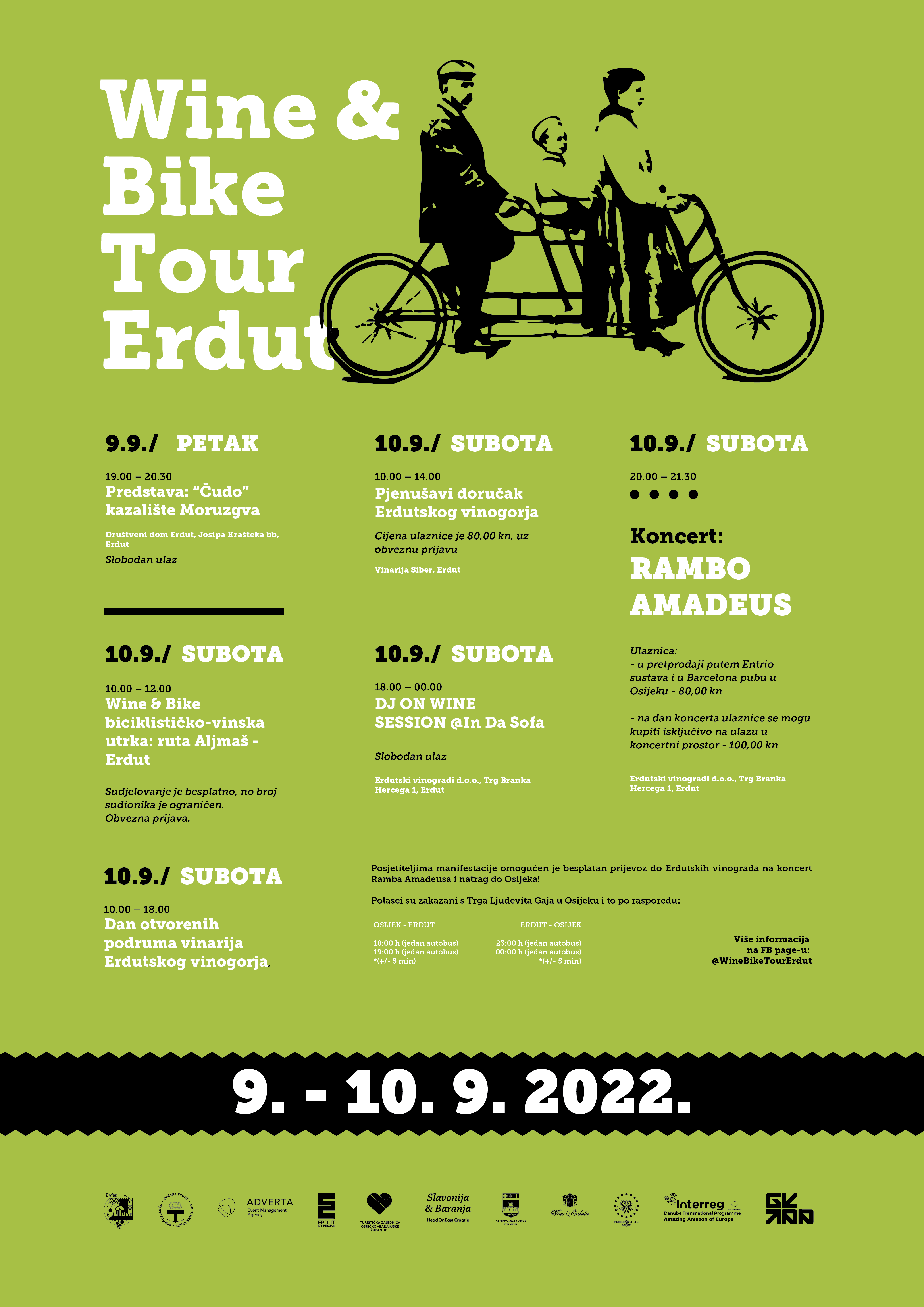
Osijek-Baranja County Tourist Board
PROGRAMME:
September 9 (Friday)
19.00 – 20.30 Performance: "Miracle", Moruzgva Theater
Free admission
Location: Erdut community centre, Josipa Krašteka bb (county road Aljmaš – Erdut)
September 10 (Saturday)
10.00 – 12.00 Wine & Bike bicycle-wine race: route Aljmaš - Erdut
Competitors will have the task of collecting wine bottles at specific locations along the route.
The winner of the race will be the participant who manages to collect and bring the highest number of bottles in the shortest possible time. All participants get to keep the bottles they collected, while the winner also wins an additional prize.
Participation is free, with mandatory online registration through the link:
The number of participants is limited.
10.00 – 18.00 Open Cellar Day
Wineries of the Erdut Vineyards: Danubio, Brzica, Erdutski Vinogradi, Siber, Magistra and Antunović.
https://tz.opcina-erdut.hr/enogastronomija/
10.00 – 14.00 Sparkling breakfast of the Erdut Vineyards
At the sparkling breakfast of the Erdut Vineyards, organised by the Salon of Sparkling Wines, the Siber Winery and Osijek-Baranja Tourist Board, the sparkling wines of the Erdut Vineyards will be presented along with homemade Slavonian snacks. After breakfast, Erdut's "En Primeur" will be held, tasting of the premier wines selected by the respective wineries.
The ticket price is HRK 80.00, with mandatory online registration.
Location: Winery Siber, Erdut, Cesta Svetog Martina
20.00 – 21.30 Vineyard Concert in the: Rambo Amadeus
Tickets costing HRK 80.00 are available online through the Entrio system and in the Barcelona Pub in Osijek. The price on the day of the concert is HRK 100, and tickets can be purchased at the entrance to the concert venue
Location: Erdutski vinogradi d.o.o., Trg Branka Hercega 1, Erdut
18.00 – 00.00 DJ ON WINE SESSION @In Da Sofa
Free admission
Location: Erdutski vinogradi d.o.o., Trg Branka Hercega 1, Erdut
For more, make sure to check out our dedicated Lifestyle section.
Escape to Osijek-Baranja County and its Epic Sights and Flavours
May 14, 2021 – Breathtaking views of the Danube at Erdut and Aljmaš, the bona fide masterpiece of Đakovo cathedral, the unique winemaking traditions of northern Baranja, the wildlife-rich wetlands of Kopački rit and the OPGs of Osijek-Baranja County. There's a whole other world to discover in this epic corner of Slavonia-Baranja.
It seems like the world is speeding up. Everything now is that much more immediate. In this age of Instagram and 'influencers', we quickly scroll past postcard-pretty pictures on our phones. 'Like'. Forgotten, in an instant.
Croatia is a country not without postcard-pretty pictures. But, to snatch attention in this super-fast, vacuous age, all too often we are shown the same images. Heart-shaped islands from above, dolphins at dusk, sunset over the Adriatic and its epic Dinaric Alps. You could be forgiven for thinking that every view in Croatia contains the sea.
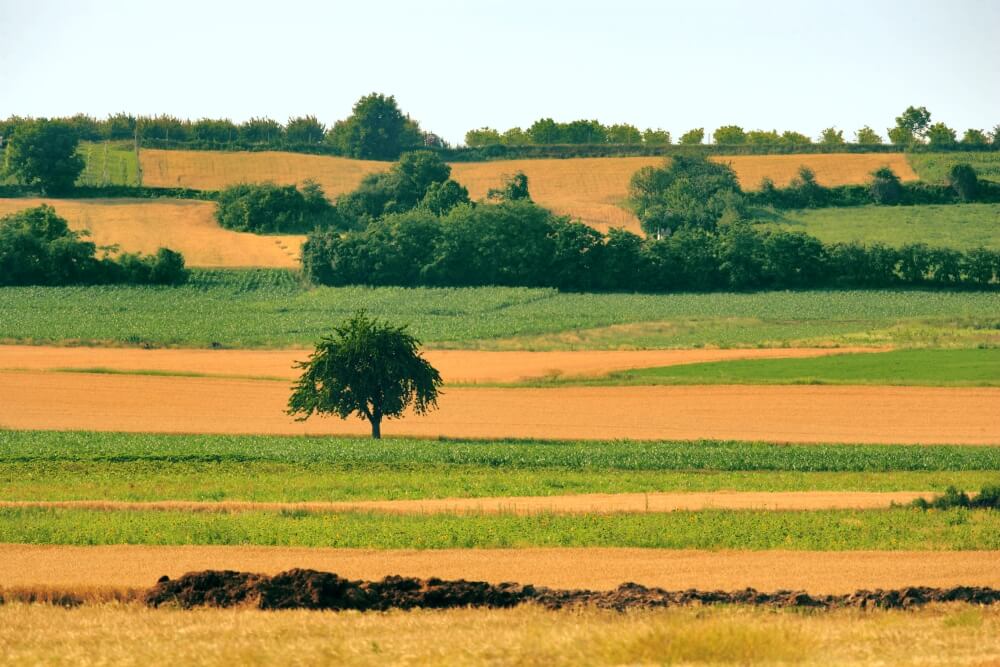 Slavonia © Romulić & Stojčić.
Slavonia © Romulić & Stojčić.
There are very few mountains in the Pannonian basin. And there is no sea. Well, not any more. Instead, these flatlands stretch 600 km from east to west and 500 km from north to south through several countries. They engulf the eastern section of Croatia we know as Slavonia, Baranja and Srijem.
Unsurprisingly, such a vast plain is not without its epic qualities. But, the epic nature of Osijek-Baranja County in Slavonia-Baranja is difficult to capture in a competing image on social media. Its special qualities instead lie in the sounds, the tastes, the tradition, the sights and the people. This is a place that has to be visited to be understood. And, if you do, it's an experience that will far outlast any fleeting photo on Instagram. Here, we take a look at just a small section of the unforgettable offer in Osijek-Baranja.
Imperial horses and the bona fide masterpiece of Đakovo cathedral
State Stud Farm Đakovo
Horse breeding in Đakovo is thought to be even older than 1506 when first written mention of the town's stud farm comes from. An endeavour of regional bishops, it bred horses of Arab stock. But, that changed at the beginning of the 19th Century.
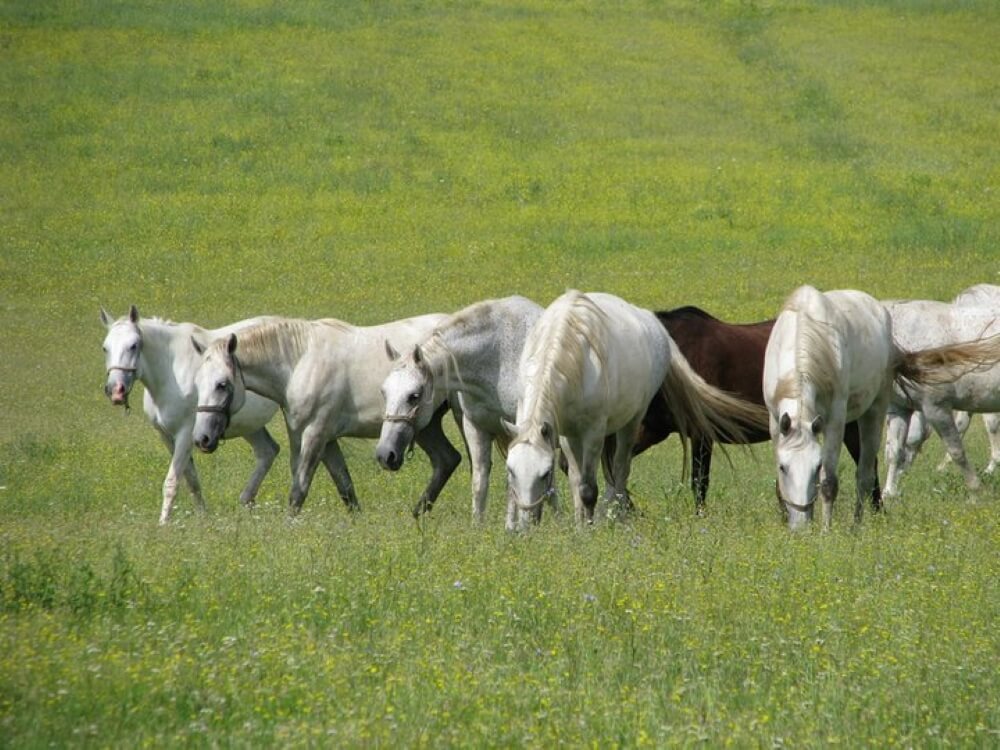 In the fields, Lipizzaner horses © Silvija Butković.
In the fields, Lipizzaner horses © Silvija Butković.
Lipizzaner horses were the prized breed of the Habsburg monarchy, their genetic line today traced back to eight stallions from the late 18th and early 19th centuries. With the advancement of Napoleon's army across Europe, Lipizzaners were sent further east in order to protect them. This imperial horse has been bred in Đakovo ever since.
Born with black skin and black hair, their hair gradually turns to a characteristic light grey (although, some other colours occur). Traditionally, when the colour change was fully complete, the horses were ready for royal duty.
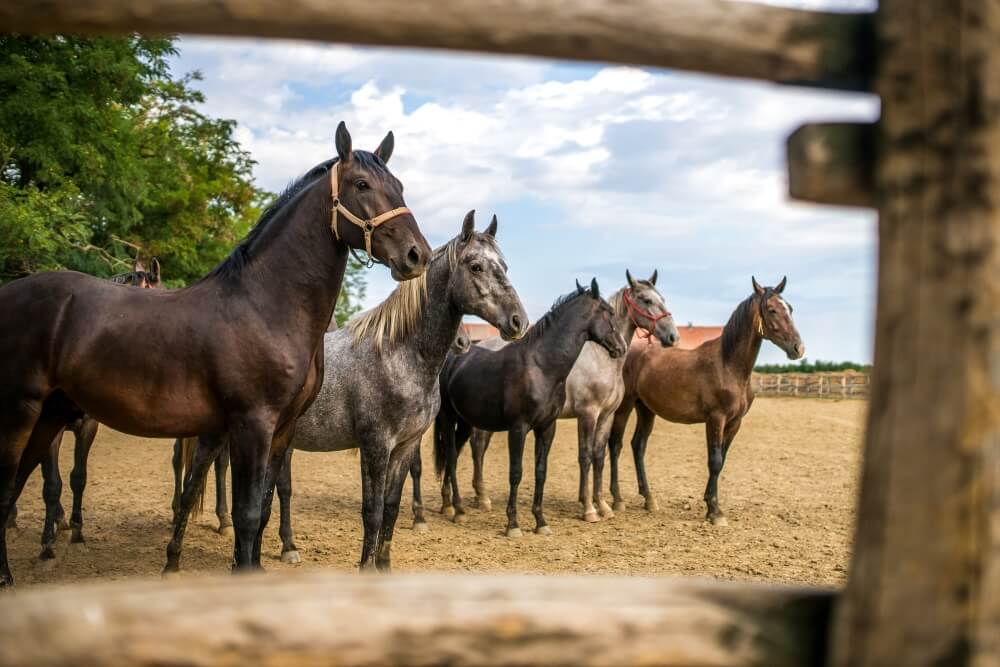 Younger horses on the State Stud Farm in Đakovo © Denis Despot / Tourist Board of Osijek-Baranja County.
Younger horses on the State Stud Farm in Đakovo © Denis Despot / Tourist Board of Osijek-Baranja County.
Today, at the State Stud Farm Đakovo, the Lipizzaners are bred and trained in dressage. The farm contains Croatia's largest indoor riding hall, in which public performances take place. Previous visitors to the farm include several members of the British Royal family. Queen Elizabeth II, Prince Phillip and their daughter Princess Anne came in 1972, while Camilla, Duchess of Cornwall came in 2016.
Đakovo cathedral
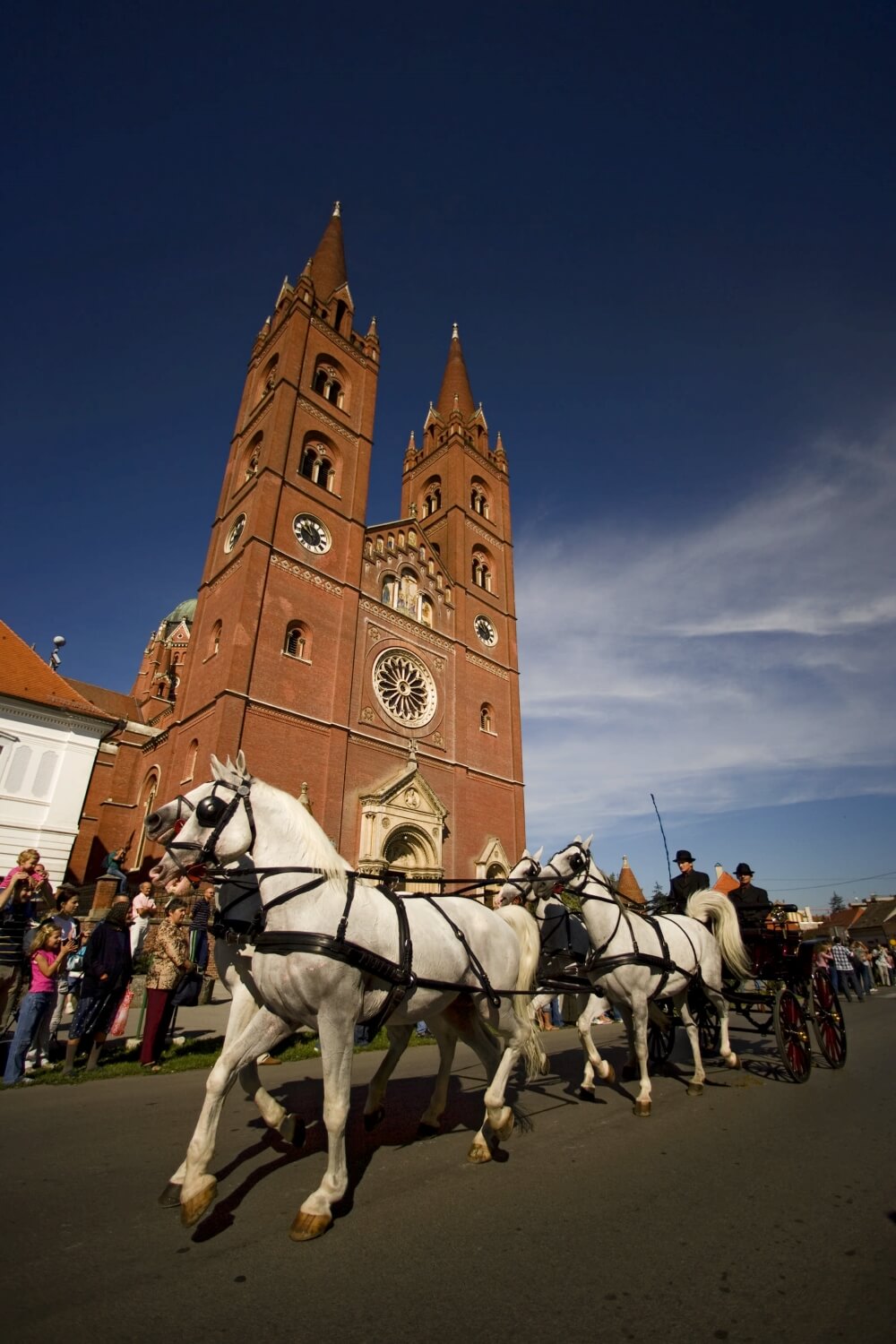 Exterior of Đakovo cathedral © Romulić & Stojčić.
Exterior of Đakovo cathedral © Romulić & Stojčić.
The presence of Bishop Josip Juraj Strossmayer looms large in the history of Croatia. Nowhere does that presence loom larger in a physical manifestation than Đakovo cathedral. By far, it is the largest sacral building in Slavonia, the second-largest in Croatia.
 © Romulić & Stojčić
© Romulić & Stojčić
This part of Slavonia is completely flat. Therefore, you can see the cathedral for miles as you approach Đakovo. Once up closer, its red bricks give it the appearance of a modern building. In fact, Josip Juraj Strossmayer oversaw its construction between 1866-1882. In truth, he'd wanted to build it for much longer, but struggled to get the funds required for his vision. Indeed, the project was so delayed that the artist Strossmayer chose to paint the interior, German Nazarene Johann Friedrich Overbeck, died before he could begin the task. Instead, father and son Alexander Maximilian Seitz and Ludwig Seitz assumed the task.
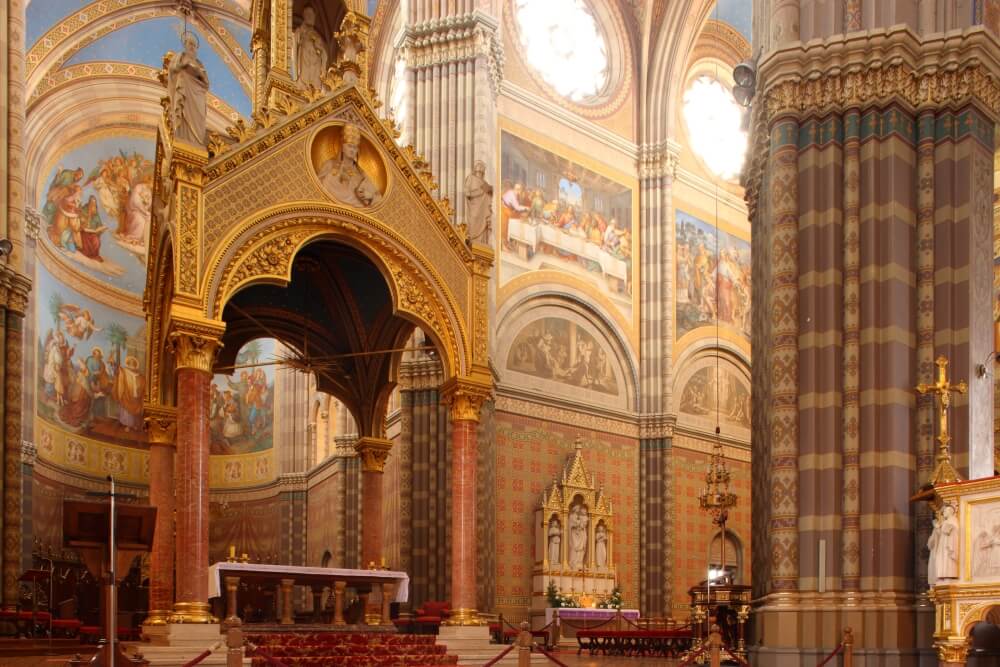 Interior detail in Đakovo cathedral © Romulić & Stojčić
Interior detail in Đakovo cathedral © Romulić & Stojčić
The building's construction actually only took four years, but it took a full 19 years to complete decorations inside. It's easy to see why. The interior of Đakovo cathedral is a bona fide masterpiece. Ornate frescos depicting scenes from the Old Testament and New Testament radiate from above. Regardless of your faith, it is a breathtaking experience to walk within.
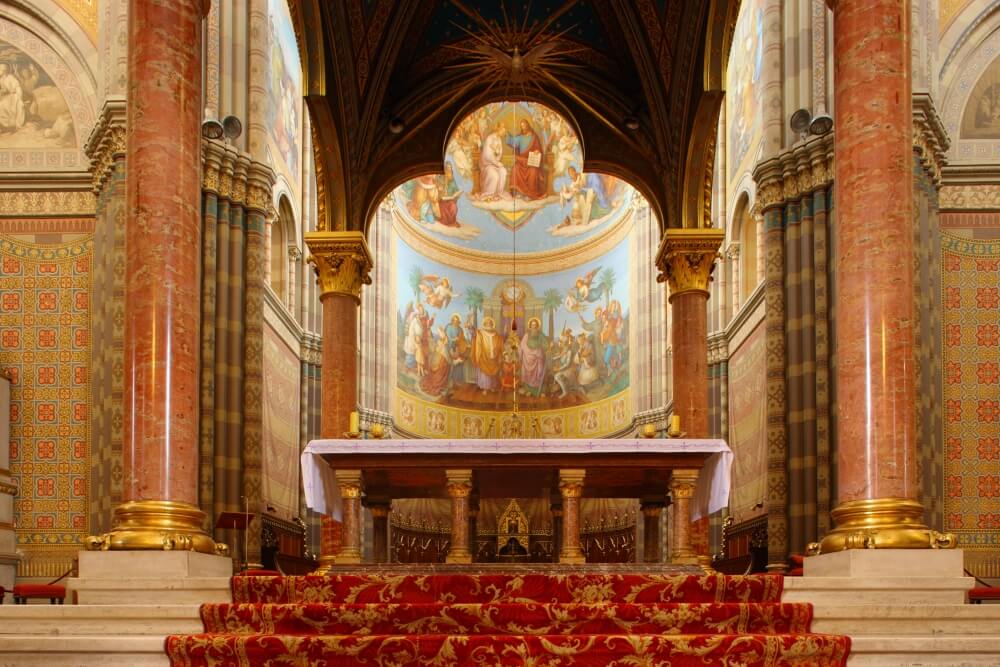 © Romulić & Stojčić
© Romulić & Stojčić
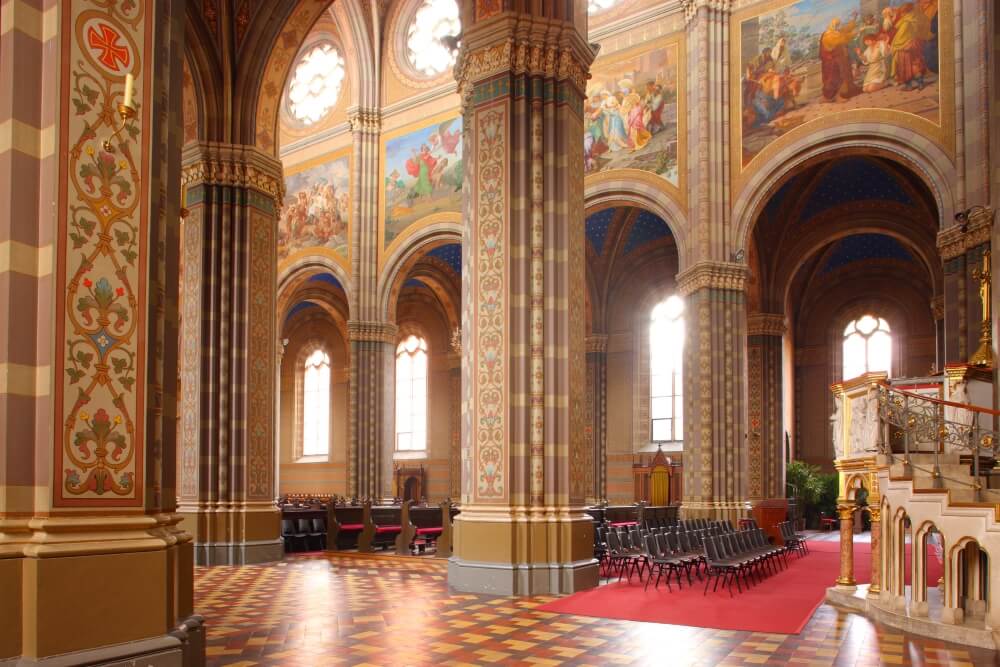 © Romulić & Stojčić
© Romulić & Stojčić
13 of the frescoes are by Alexander, 20 are by Ludwig. The detail of their work captivates the eye. The Neo-Romanesque architectural flourishes design inside are similarly grandiose. Visiting while on a journey to Bulgaria, future Pope John XXIII proclaimed it to be the most beautiful church between Venice and Constantinople.
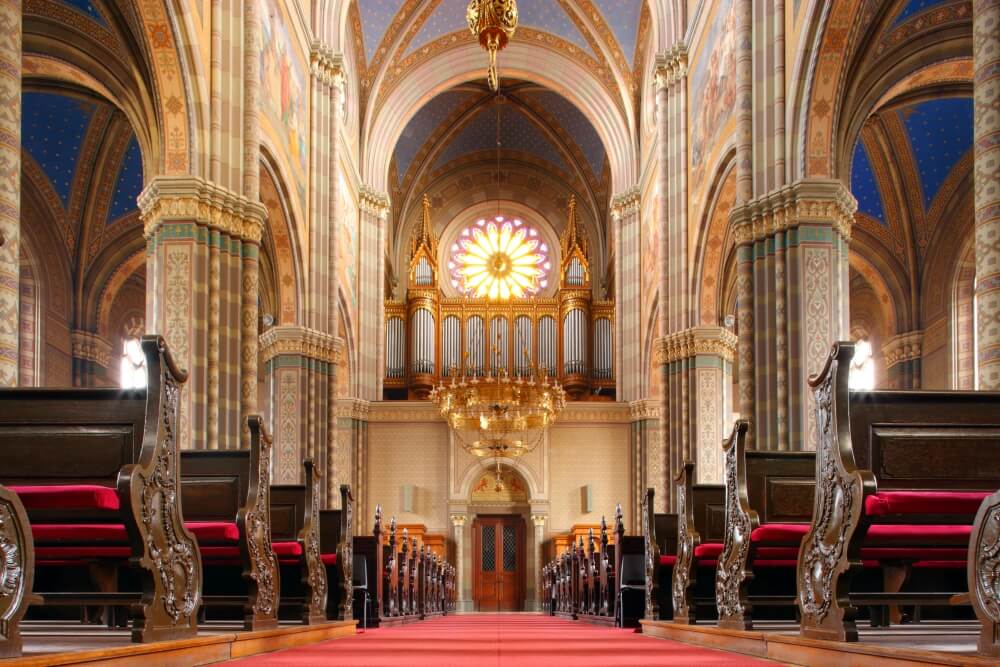 © Romulić & Stojčić
© Romulić & Stojčić
Breathtaking views of the Danube at Erdut and Aljmaš
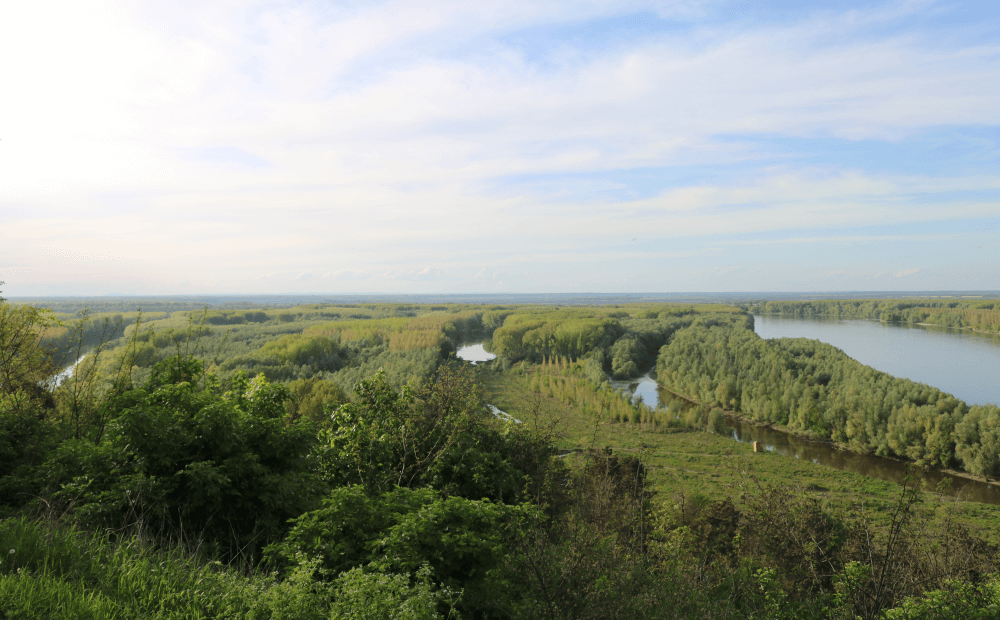 The Danube, as seen from the Brzica winery terrace in Erdut © Marc Rowlands.
The Danube, as seen from the Brzica winery terrace in Erdut © Marc Rowlands.
Slavonia is defined by its two longest rivers. To the south, after passing through Zagreb and Lonjsko Polje, the Sava forms a natural border between Slavonia and Bosnia. To the north, the Drava river first separates Croatia and Hungary. Then, after Donji Miholjac, it serves as the border between Slavonia from Baranja. Just a mile or so from Aljmaš, the Drava flows into the Danube, which partially separates Slavonia from Vojvodina.
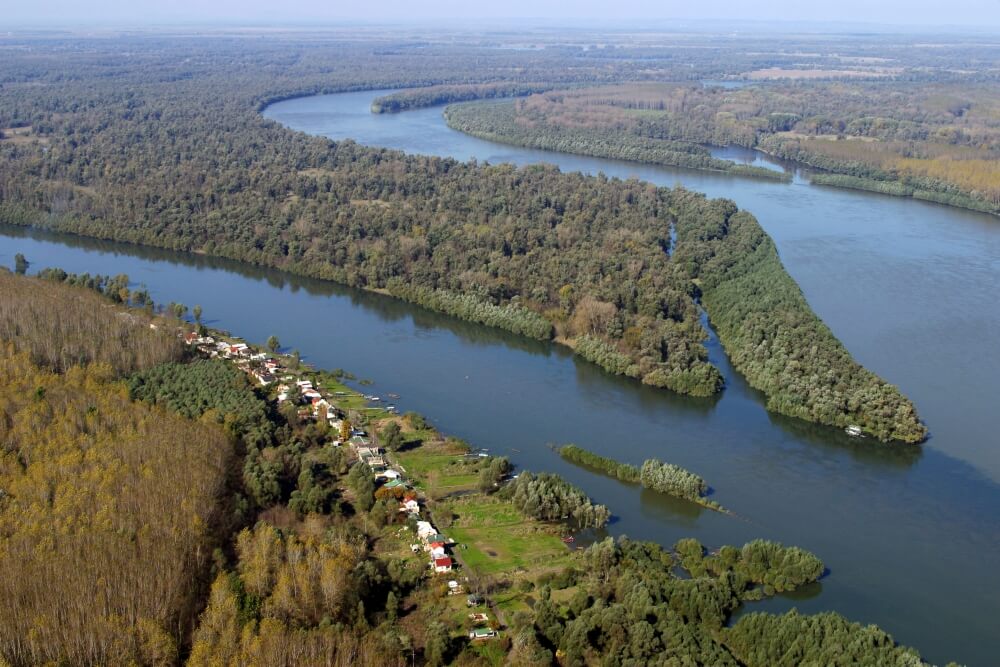 The Danube in eastern Slavonia © Romulić & Stojčić.
The Danube in eastern Slavonia © Romulić & Stojčić.
When you're standing overlooking the Danube in Erdut village, you could almost believe you're on an island. The peninsula in which the village lies is surrounded on three sides by the Danube. It weaves in and out of the landscape, causing great gulfs between the dense forest that occurs on each side. This area is noticeably raised above the height of regular, flat Slavonia and in Erdut, a small castle tower stands on a hill. It's one of the best places to look at the Danube. The other is from the Brzica winery, less than a kilometre away.
At Brzica, you're some 80 metres above the Danube. Here, winery owner Ivo Brzica has taken advantage of the view. He's built a beautiful holiday home where guests can stay. It's right next to his own dwelling and the winery. The properties share a huge, open and informal terrace overlooking the river. It's a great place to try the award-winning Brzica wines. They plant Graševina, Chardonnay, Cabernet Sauvignon, Merlot and Vranac. On some bottles, the label reads 1378. It's the number of kilometres the Danube has travelled to reach this point.
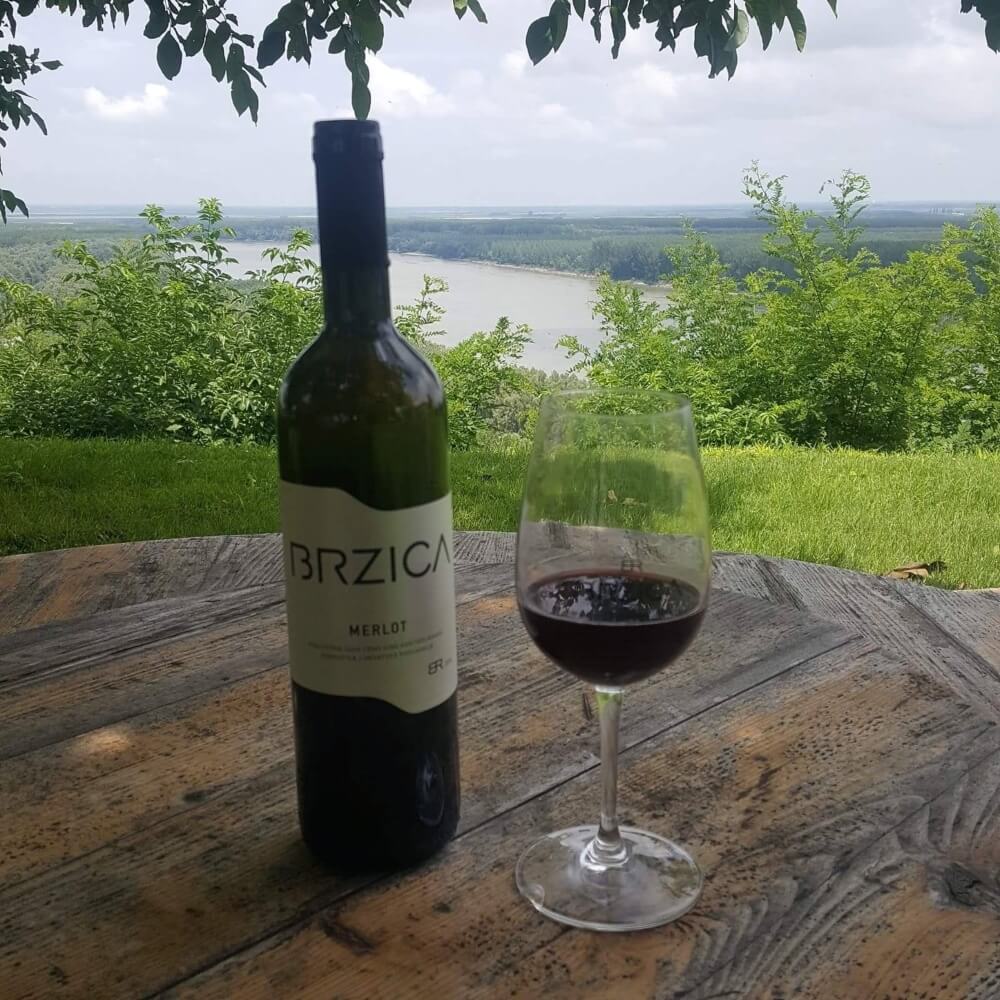 A glass of Brzica wine overlooking the Danube.
A glass of Brzica wine overlooking the Danube.
Erdut visitors wanting to get up closer to the Danube can now do just that. A newly appointed 10-kilometre footpath now runs alongside the river all the way from Erdut to Aljmaš. It's a beautiful walk through epic nature.
The unique landscape and winemaking traditions of northern Baranja
While much of Slavonia is uniformly flat, the topography is more varied in Baranja. Baranja Mountain stretches in a northeast-southwest direction between Beli Manastir and Batina. It is 21 kilometres long, three kilometres wide and much of its slopes are used for agriculture, grapes for winemaking, predominantly.
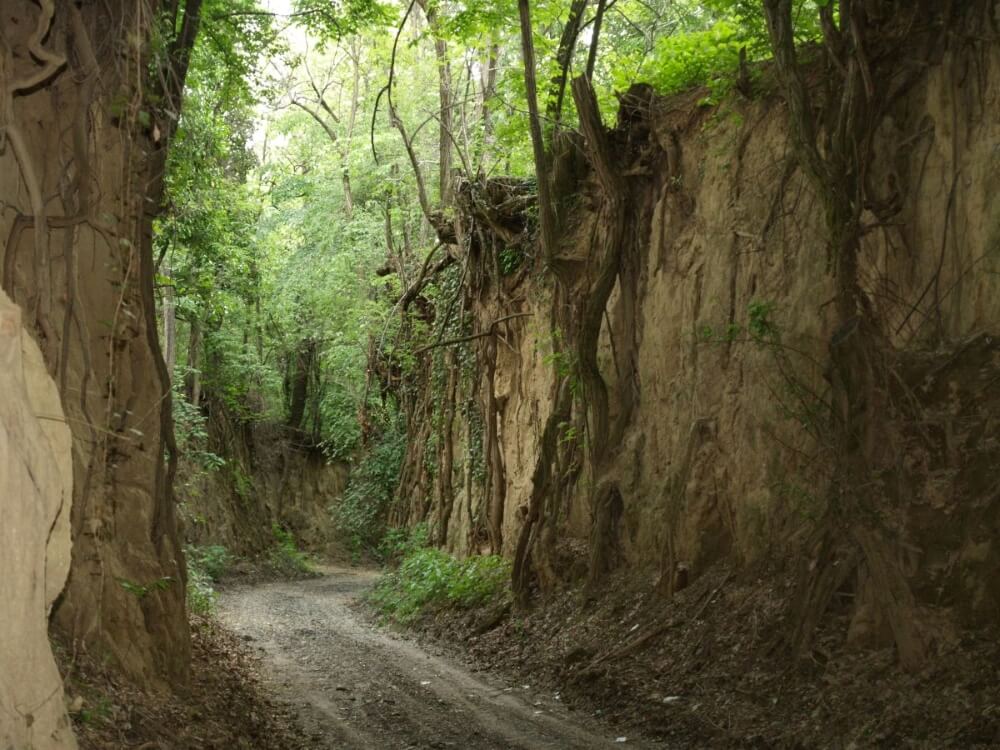 A Surduk in Baranja © Krešimir Čandrlić / Tourist Board of Osijek-Baranja County.
A Surduk in Baranja © Krešimir Čandrlić / Tourist Board of Osijek-Baranja County.
Long ago, heavy rains began to produce natural gorges which cut through the higher ground. Over time, some of these became considerably deep, widened by the flow of water and sometimes mud. Eventually, these gorges between hillsides became passageways for horses and carts. In Croatia, these narrow routes are exclusive to the Baranja region and are very pretty to walk. Their walls are lined with tree roots, which stop them from collapsing. The branches and leaves of these trees often overhang the gorge, sometimes giving you the impression you're in a tunnel. Such a route in Baranja is known as a Surduk.
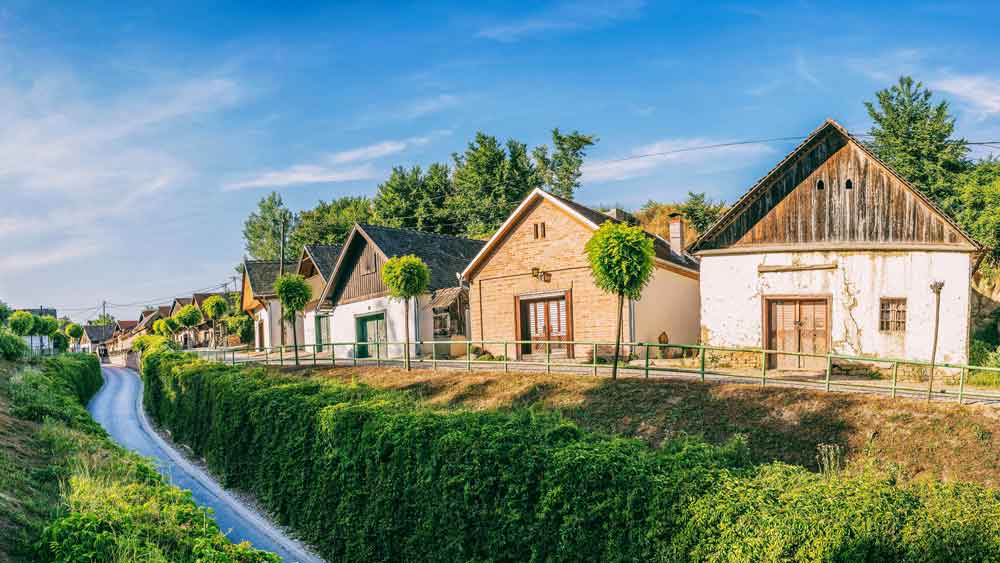 A line of traditional Baranja wine cellars. Unique in Croatia to Baranja, such a building is known as a Gator © Visit Baranja.
A line of traditional Baranja wine cellars. Unique in Croatia to Baranja, such a building is known as a Gator © Visit Baranja.
On this same ground, you'll find another phenomenon unique to Baranja. A Gator is a traditional wine cellar of this region. Sometimes found on the lower course of a Surduk, a Gator is unlike a typical wine cellar in that it has no subterranean section where the wine is stored. Instead, a Gator extends back into the hillside. Wine is kept in the deepest recesses of the building, where it is coolest. In several places in Baranja you can see a street with several of these buildings side by side. Usually, each Gator is owned by a different family and each will make their own particular family wine.
Podrumi Kolar family winery in Suza
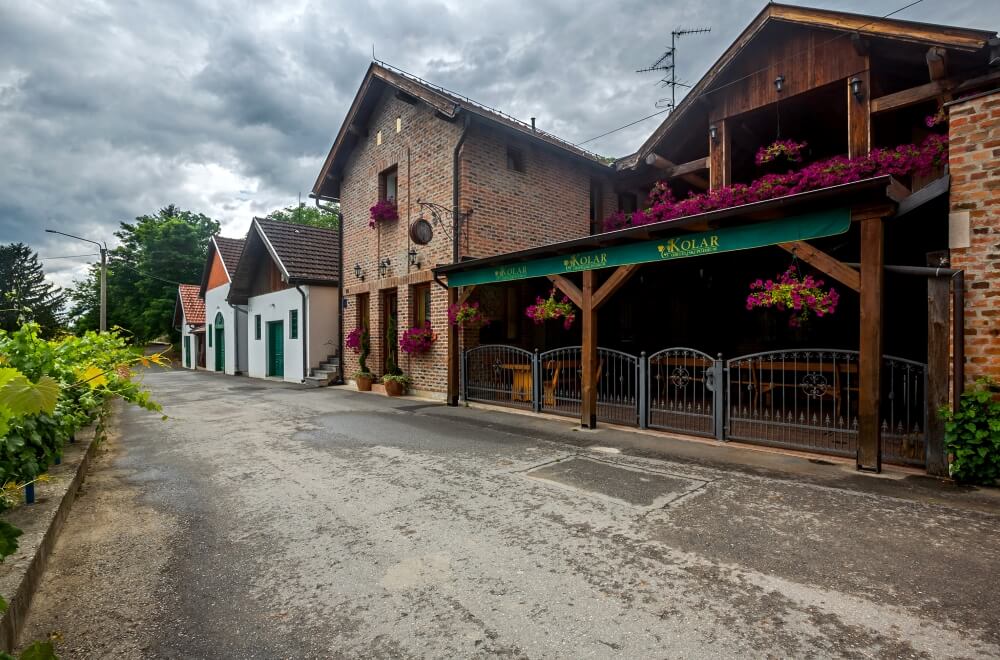 With a 100-year-old cellar and great wines, the Podrumi Kolar family winery in Suza.
With a 100-year-old cellar and great wines, the Podrumi Kolar family winery in Suza.
The Kolar family wine cellar is 100 years old, although the restaurant and tourism aspect of their enterprise has only been around since 2004. The whole family are involved and they purposefully intertwine their winemaking with a visitor offer. In addition to the restaurant attached to the wine cellar and they have a wonderful campsite just a couple of hundred metres down the road. All of their wines are great. But, if you visit, be sure to try their Sauvignon. Some say it's the best in the whole of Baranja.
Josić winery and restaurant in Zmajevac
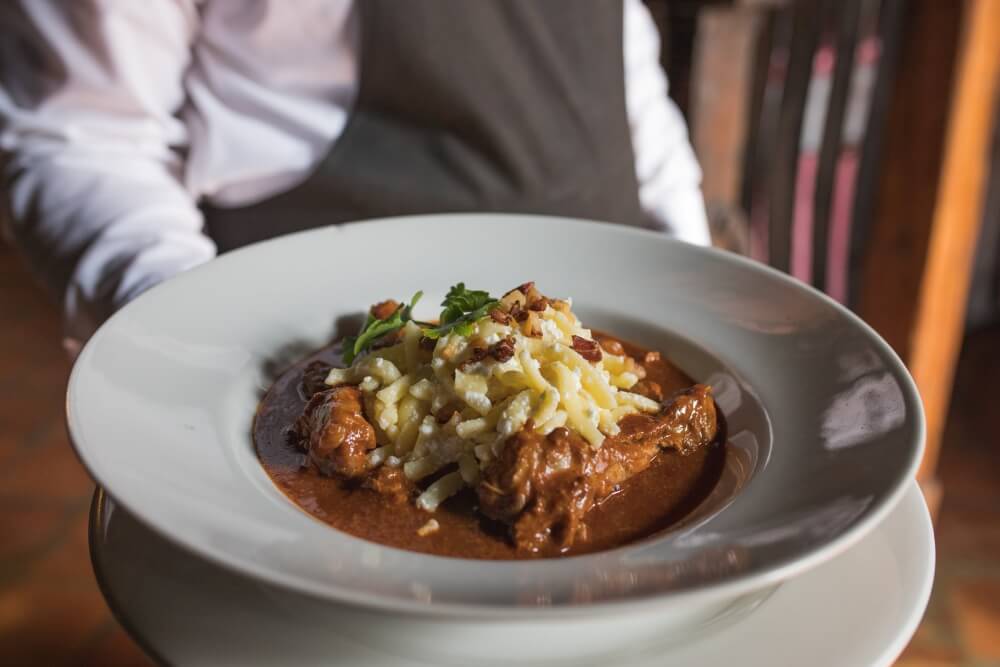 Traditional Baranja and Slavonia flavours at the Josić winery and restaurant in Zmajevac.
Traditional Baranja and Slavonia flavours at the Josić winery and restaurant in Zmajevac.
At the Josić winery and restaurant in Zmajevac they make brilliant wines. Among them, Baranja shiller, Cabernet Sauvignon, Chardonnay, Graševina, Pinot Gris and Sauvignon. You can visit the wine cellars and try traditional foods of the region in their extensive restaurant.
Vinarija Gerštmajer in Zmajevac
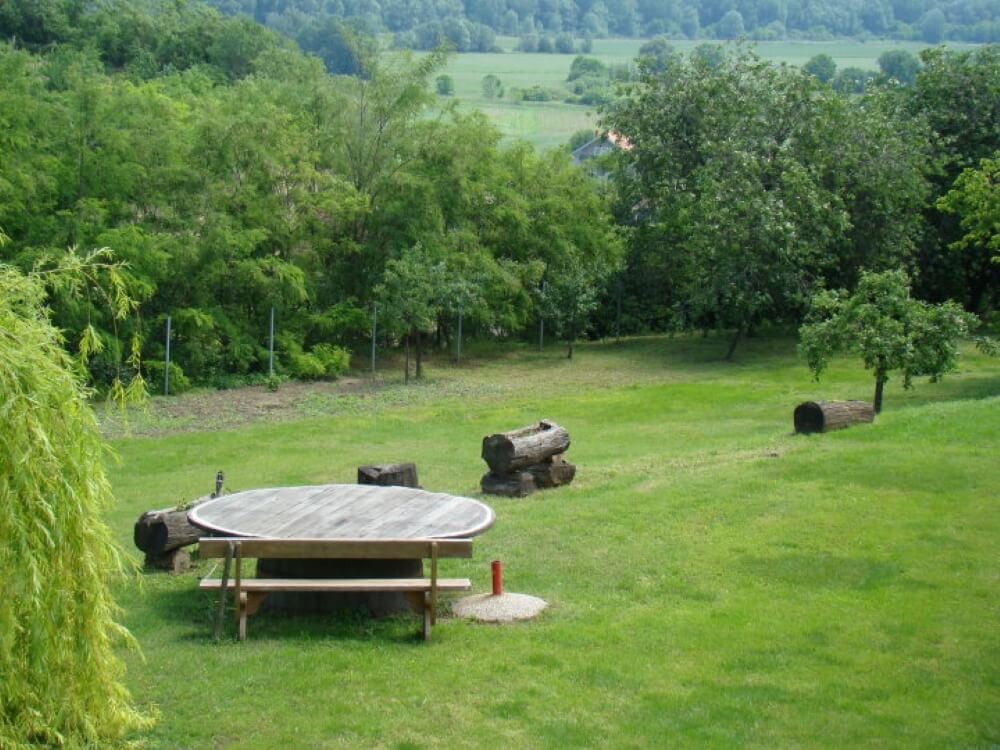 Incredible views from the garden at Vinarija Gerštmajer in Zmajevac.
Incredible views from the garden at Vinarija Gerštmajer in Zmajevac.
A deep dust gathers on some of the oldest bottles kept in the cellar at Vinarija Gerstmajer. And, there's plenty of those. The charming family patriarch is clearly a proud wine enthusiast and reserves some bottles from every year of their celebrated but small production. Sadly, this archive now stretches back only until the mid-1990s. It used to be much older, cataloguing all of the years his own father ran the winery. But, when the family returned after the war, they were greeted by empty cellars. The cellars are once again full. You can try them in the cellar or out on the terrace, overlooking a scene of uninterrupted nature.
The wildlife-rich wetlands of Kopački rit
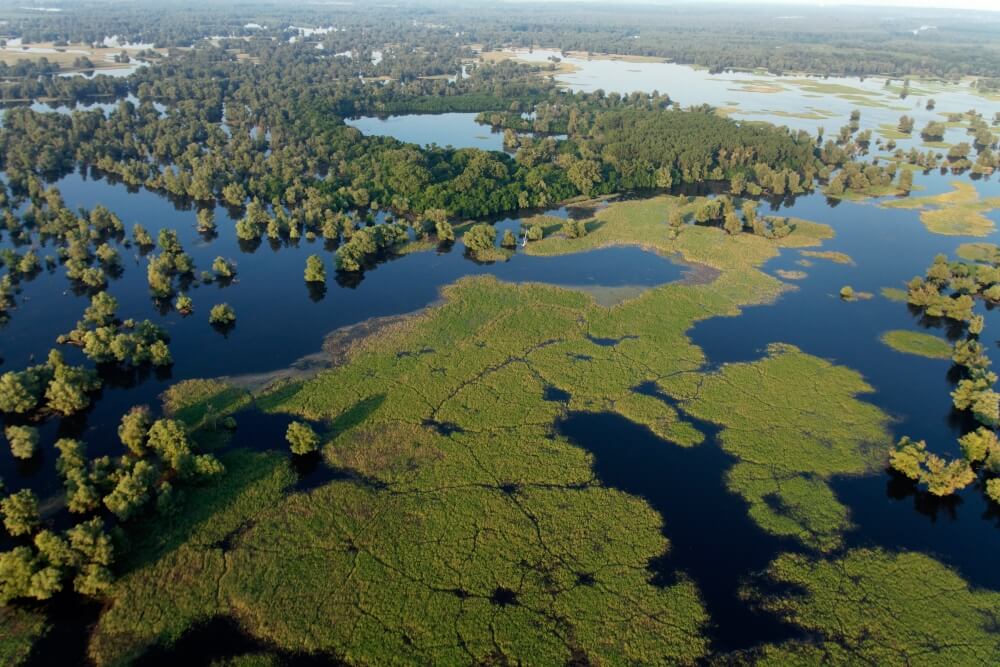 Wetlands of Kopački rit © Tourist Board of Osijek-Baranja County.
Wetlands of Kopački rit © Tourist Board of Osijek-Baranja County.
Occupying the marches, lakes and floodland between the Drava and the Danube, Nature Park Kopački rit is one of Europe's largest wetlands. Although a home to many different types of life, it is most famous for its bird population. As many as 300 different species of birds inhabit the park, many of them being migratory and nesting species. Of particular note, a large colony of grey heron and and the largest population of woodpeckers in the entire Danube basin. You can now tour a section of the waters in a large visitor boat. It is electrically powered so as not to disturb the life-rich riverbanks. After the boat drops you off, make your way through the rest of the park across specially constructed pathways that wind their way across the waters and reeds.
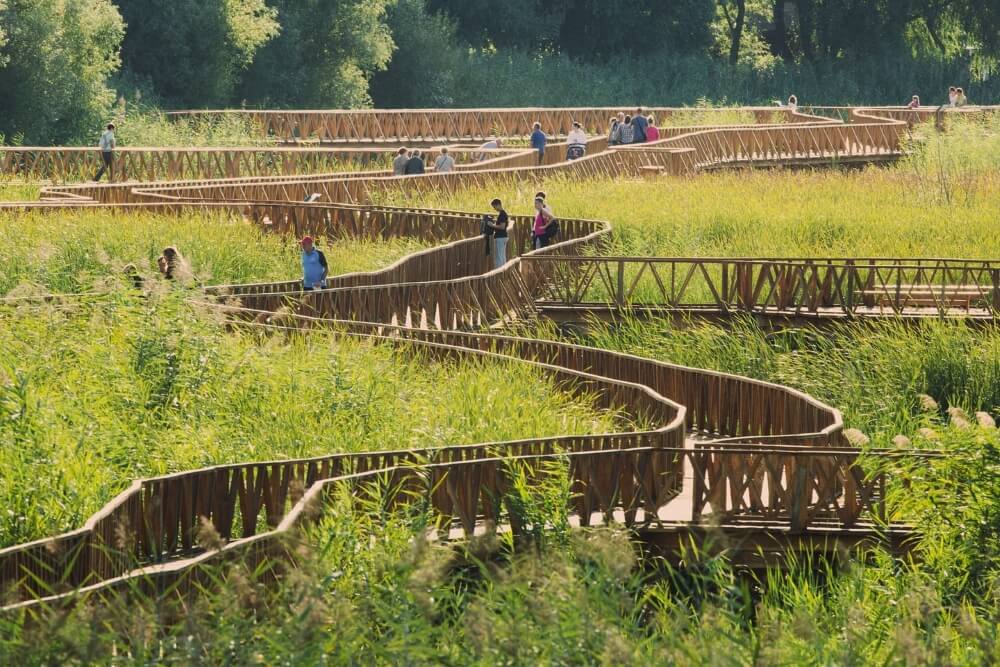 The wooden walkways of Kopački rit Nature Park in Osijek-Baranja County © Romulić & Stojčić.
The wooden walkways of Kopački rit Nature Park in Osijek-Baranja County © Romulić & Stojčić.
The OPGs of Osijek-Baranja County
The landscape in Osijek-Baranja County is only so picturesque because of the people who live in it. It is their endeavours that shape it. Traditional agricultural pursuits explain the pretty rows of vineyards, the different coloured fields and gardens filled with fruit trees. While some agriculture here exists on a grand scale, many families in the region make the most of their own small plots of land.
Osijek-Baranja County family farms or OPGs preserve the traditions of the region, not only in the way they use the land but in the produce that results. From the beekeeping that makes EU-protected honey to the vineyards producing Croatia's best white wine, practices in these family farms are often passed down from generation to generation. The best way to learn how they do it – and try the amazing traditional flavours of Osijek-Baranja County – is to go to an OPG. Here are just several you can visit.
Zorić distillery in Erdut
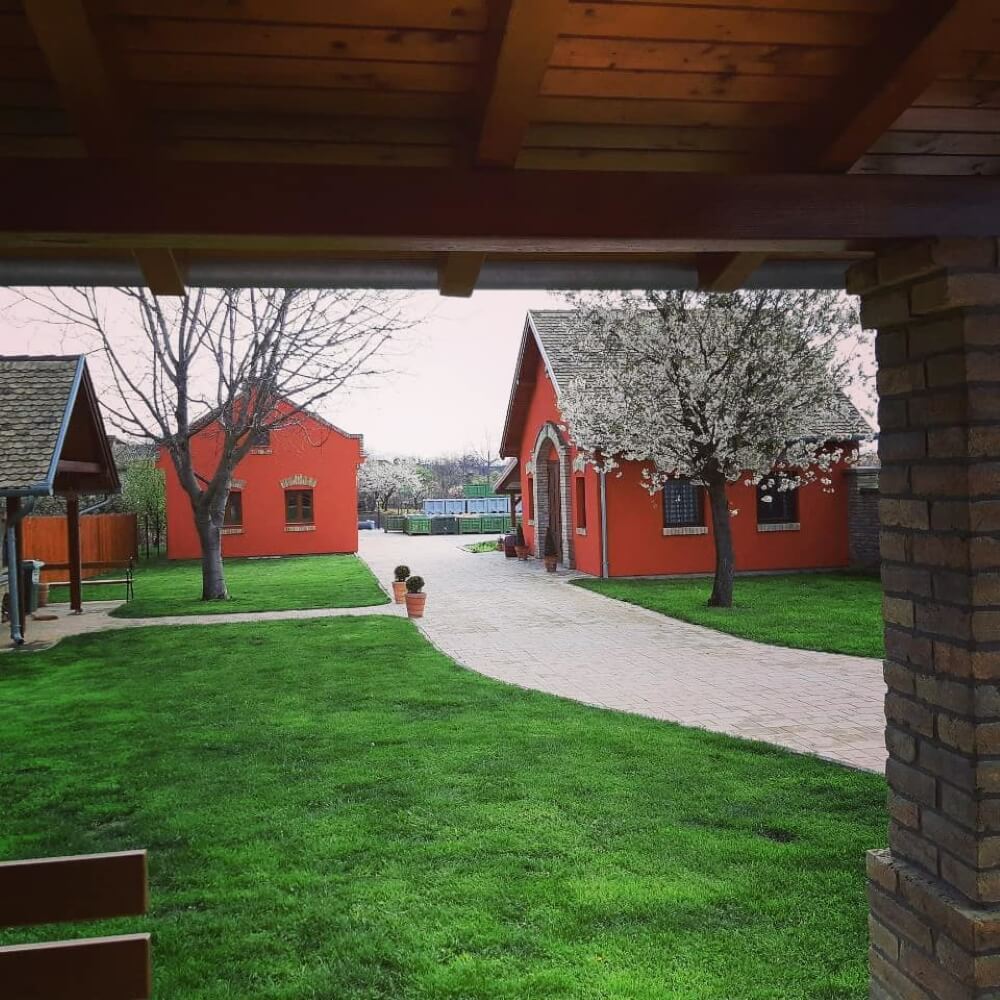 Zorić distillery in Erdut, Osijek-Baranja County.
Zorić distillery in Erdut, Osijek-Baranja County.
The Zorić family in Erdut have long been growing fruit and making Croatian brandy aka rakija. But, this youngest generation, lead by youthful father Dinko and his wife Sanja, have upped their game significantly. They have built the most modern craft rakija distillery in the region. From there, they make one of Croatia's best new premium rakijas, Divania. In English or Croatian, they will guide you around the distillery and explain the process before letting you try it on their lovely terrace. If you're lucky, you might also get to try the family-made kobasica sausages – they're very good! Their rakijas are made from apricots, quinces, apples, pears and cherries and the family are great hosts.
Seoski turizam Lacković in Bilje
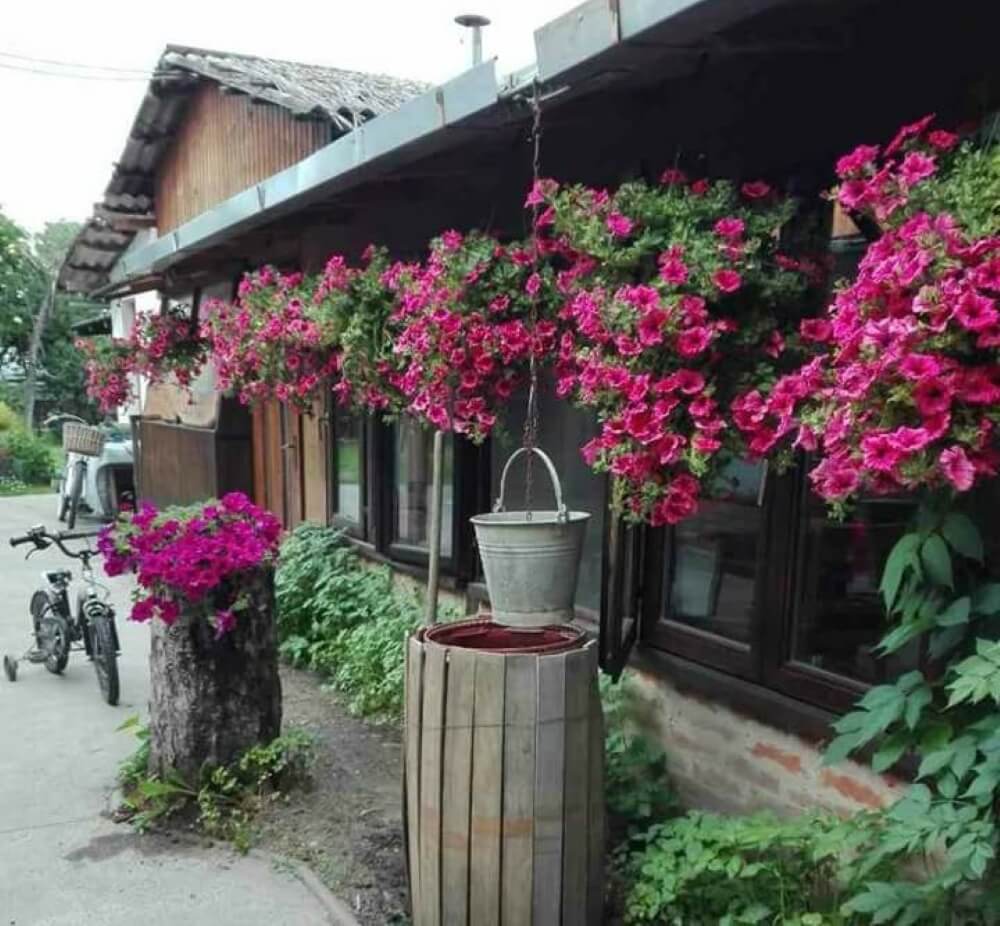 Filled with flowers, Seoski turizam Lacković in Bilje.
Filled with flowers, Seoski turizam Lacković in Bilje.
A beautiful family-run farm, with 16 beds for guests, Seoski turizam Lacković are used to hosting visitors. The farm itself has pretty rows of vegetables out back. Next to them, a variety of birds are kept. The hosting area has a lovely terrace with a view of the pretty tree-lined path that extends down through the large garden. During the recent Month of Baranja Cooking (Mjesec baranjske kuhinje), visitors tried their hand at making traditional baked foods pita and kiflice.
OPG Čudesna šuma
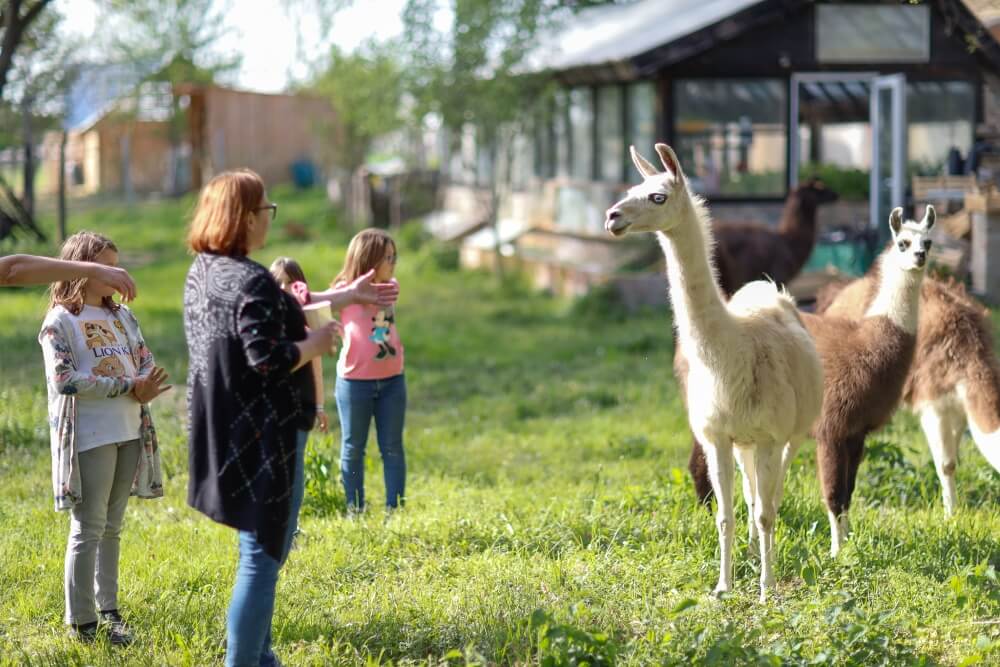 Meeting the llamas at OPG Čudesna šuma © Turistička zajednica Općine Bilje - Kopački rit.
Meeting the llamas at OPG Čudesna šuma © Turistička zajednica Općine Bilje - Kopački rit.
Visit the llamas or a special gastronomic event at this future eco-village and food forest. To read a detailed reportage from our spring 2021 visit to OPG Čudesna šuma, look here.
Both the author and Total Croatia News would like to thank the following for their invaluable help in creating this article: Ivana Jurić and the Tourist Board of Osijek-Baranja County, Marija Burek and the Tourist Board of Đakovo, Renata Forjan and Turistička zajednica Općine Bilje - Kopački rit and Domagoj Butković of expert travel guides to Slavonia and Osijek-Baranja County, Kulen travel.
2nd DunavArt Festival Concludes
It was another successful edition of the festival fcocused on the Danube region.


